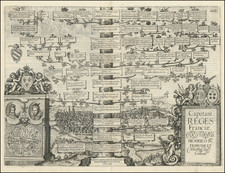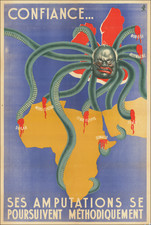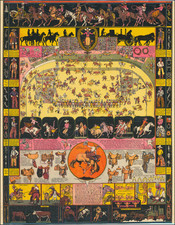This image is from the German edition of Mallet's Description de L'Univers, Beschreibung des Ganzen Welt Kreiss, a text which details the many ways in which the universe can be studied, and what scholars knew about it at the time. This image, Figure 6 in the work, shows the position of an equator on a globe, along with several other images of globular cartography.
The centerpiece of the figure is an armillary sphere, also known as a spherical astrolabe. This instrument shows the equinoctial, ecliptic, and tropical lines. The Meridian is labeled in the image. The sphere stands atom a Nicolosi globular world map, showing what can be guessed as Eurasia and Africa in green and the Americas in pink. Aside it are a celestial globe, showing the constellations, and a terrestrial globe. The theme in all of these images is the equator (or, the "middle line"), as named atop this work.
This appears in a section of Mallet's Beschreibung des Ganzen Welt Kreiss which details the important lines of the earth and instructs the reader on the proper use of an armillary sphere. This image acts as a nice visual summary of the points Mallet had already discussed in the text.
Alain Mannesson Mallet (1630-1706) was a French mapmaker and engineer who served in the armies of Louis XIV. After rising through the ranks, Mallet was appointed as Inspector of Fortifications, a job which also required mathematical skills and which made him a competent military engineer. Eventually, he joined the court of Louis XIV at Versailles, where he taught math and focused on writing.
Mallet is best known for his Description de L’Univers, first published in 1683, in five volumes. A wide-ranging geographical work, the Description included textual descriptions of the countries of the world, as well as maps of the celestial sky and the ancient and modern worlds. The Description continued to be published until the early eighteenth century. He also published a work in three volumes on warfare (1684) and a primer on geometry (1702).









![[Surf's Up and Down!]](https://storage.googleapis.com/raremaps/img/small/76816.jpg)
![[Manuscript Title Page and Table of Contents for a large Composite Atlas with maps by De L'Isle, De Fer, Le Rouge, Nolin, Bellin and others]](https://storage.googleapis.com/raremaps/img/small/88241.jpg)

![[First California Wine Making Image] The Vintage In California -- At Work At The Wine Presses](https://storage.googleapis.com/raremaps/img/small/89054.jpg)

